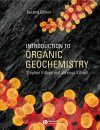![An Introduction to Organic Geochemistry An Introduction to Organic Geochemistry]()
Click to have a closer look
About this book
Contents
Biography
Related titles
About this book
The scope of this second edition has been widened to provide a broad and up-to-date background.
Contents
Preface. 1 Carbon, the Earth and life. 1.1 Carbon and the basic requirements of life. 1.2 Chemical elements, simple compounds and their origins. 1.3 The origin of life. 1.4 Evolution of life and the atmosphere. 1.5 Major contributors to sedimentary organic matter. 2 Chemical composition of biogenic matter. 2.1 Structure of natural products. 2.2 Carbohydrates. 2.3 Amino acids and proteins. 2.4 Lipids. 2.5 Lignins, tannins and related compounds. 2.6 Nucleotides and nucleic acids. 2.7 Geochemical implications of compositional variation. 3 Production, preservation and degradation of organic matter. 3.1 How and why organic-rich deposits form. 3.2 Controls on primary production. 3.3 Preservation and degradation of organic matter. 3.4 Depositional environments associated with accumulation of organic matter. 4 Long-term fate of organic matter in the geosphere. 4.1 Diagenesis. 4.2 Humic material. 4.3 Coal. 4.4 Kerogen. 4.5 Catagenesis and metagenesis. 4.6 Temporal and geographical distribution of fossil organic carbon. 5 Chemical stratigraphy. 5.1 Biologically mediated transformations. 5.2 Examples of source indicators in recent sediments. 5.3 Diagenesis at the molecular level. 5.4 Source and environment indicators in ancient sediments and oil. 5.5 Thermal maturity and molecular transformations. 5.6 Palaeotemperature and age measurement. 5.7 Maturity of ancient sedimentary organic matter. 5.8 Isotopic palaeontology. 6 The carbon cycle and climate. 6.1 Global carbon cycle. 6.2 Changes in carbon reservoirs over geological time. 6.3 Palaeoclimatic variations. 6.4 Isotopic excursions at period boundaries. 6.5 Human influence on the carbon cycle. 7 Anthropogenic carbon and the environment. 7.1 Introduction. 7.2 Halocarbons. 7.3 Hydrocarbon pollution in aquatic environments. 7.4 Endocrine disrupting chemicals. 7.5 Environmental behaviour of selected xenobiotic compounds. 7.6 Factors affecting the rate of anthropogenic components. Appendix 1: SI units used. Appendix 2: SI unit prefixes. Appendix 3: Geological timescale. References. Index.
Customer Reviews
Biography
Dr Steve Killops has been active in the field of organic geochemistry for some 20 years, in both academic and commercial sectors. He is a former lecturer in organic geochemistry at Royal Holloway College, London University and more recently the organic geochemist at the Institute of Geological & Nuclear Sciences in New Zealand. He is currently a consultant petroleum geochemist. Vanessa Killops is a geologist and organic geochemist and has worked in petroleum exploration. She has also worked in New Zealand at the Institute of Geological & Nuclear Sciences as a contract geological scientist and in the UK on a consultancy basis.



































